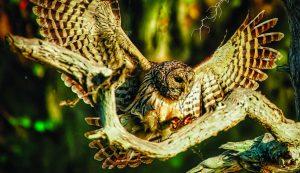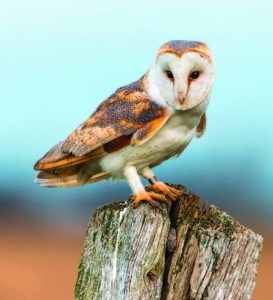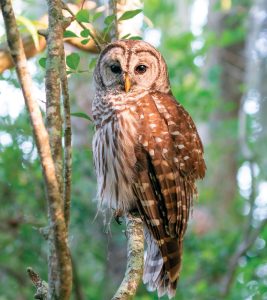
Florida is blessed with seven different owls, though some are much more common than others. The seven are the barn owl, the great horned owl, the burrowing owl, the short eared owl, the Eastern screech owl, the Northern saw-whet owl, and the barred owl. Some on the list are rarer in our state or, like the burrowing owl, only exist in Central Florida. Three species common to our area are the barn owl, the Eastern screech owl, and the barred owl.
 Barn owls (Tyto alba) have distinctive heart-shaped whitish faces along with whitish chests and bellies. Strictly nocturnal, barn owls have excellent night vision, and their hearing is also spectacular. With a wingspan of up to 50 inches, these secretive hunters hover over fields and meadows waiting for their next meal. Prey consists of rabbits, mice, voles, and (rarely) other birds; squirrels are relatively safe from these owls. They swallow prey whole then cough up undigestible parts as pellets. There are over 46 types of barn owl worldwide, but ours is the largest and twice the weight of the Galapagos barn owl. The range of the beautiful barn owl is the majority of the lower 48 states, Central America and the Caribbean islands, such as Cuba. It is called a barn owl because it will use man-made structures, such as barns or other buildings, to build its nest. The oldest barn owl in captivity lived to 15 years.
Barn owls (Tyto alba) have distinctive heart-shaped whitish faces along with whitish chests and bellies. Strictly nocturnal, barn owls have excellent night vision, and their hearing is also spectacular. With a wingspan of up to 50 inches, these secretive hunters hover over fields and meadows waiting for their next meal. Prey consists of rabbits, mice, voles, and (rarely) other birds; squirrels are relatively safe from these owls. They swallow prey whole then cough up undigestible parts as pellets. There are over 46 types of barn owl worldwide, but ours is the largest and twice the weight of the Galapagos barn owl. The range of the beautiful barn owl is the majority of the lower 48 states, Central America and the Caribbean islands, such as Cuba. It is called a barn owl because it will use man-made structures, such as barns or other buildings, to build its nest. The oldest barn owl in captivity lived to 15 years.
 The Eastern screech owl (Megascops asio) is tiny with a length of only up to nine inches and a wingspan of 20 or so inches. It is a greyish to brown bird with little feathery horns. Found in every Florida county and east of the Rockies nationally, screech owls are known for their haunting cries, which are used to signal alarm or agitation. The screeching is generally made by adults defending nests from predators. Unlike many species, the screech owl is monogamous, and males and females stay together for life. The female is slightly larger than the male, who must feed both his mate and the young before the baby birds leave the nest. Eastern screech owls eat a wide variety of prey, including songbirds and even worms. They can exist in any area that is well-treed, camouflaging themselves during the day and hunting in the evenings and at night. Other birds, such as blue jays, will sometimes “mob” these and other owls in an attempt to drive them away. Screech owls will readily use nest boxes, which should be erected prior to breeding season in the spring.
The Eastern screech owl (Megascops asio) is tiny with a length of only up to nine inches and a wingspan of 20 or so inches. It is a greyish to brown bird with little feathery horns. Found in every Florida county and east of the Rockies nationally, screech owls are known for their haunting cries, which are used to signal alarm or agitation. The screeching is generally made by adults defending nests from predators. Unlike many species, the screech owl is monogamous, and males and females stay together for life. The female is slightly larger than the male, who must feed both his mate and the young before the baby birds leave the nest. Eastern screech owls eat a wide variety of prey, including songbirds and even worms. They can exist in any area that is well-treed, camouflaging themselves during the day and hunting in the evenings and at night. Other birds, such as blue jays, will sometimes “mob” these and other owls in an attempt to drive them away. Screech owls will readily use nest boxes, which should be erected prior to breeding season in the spring.

Possibly Tallahassee’s most seen owl is the barred owl (Strix varia), also known as the swamp owl. This large brown round-headed bird has a wingspan of up to 43 inches. It is a night hunter with the easily remembered call of “Who cooks for you? Who cooks for y’all?” As a dweller in mature forests, these owls’ preferred habitats are wetlands near water, but they may be seen even in town. During the mating season, January through March, they even scream like a terrified human. With a wide choice of prey, the barred owl has one true enemy—the great horned owl. Barred owls will abandon areas that contain one of these slightly larger competitors. Interestingly, barred owls do not migrate and will live their whole lives in the same area as long as prey, primarily rodents, is available.
Having the “wise old owl” around is an indicator of good habitat. Let’s keep our trees and open spaces so we can share the land with wildlife. Keep an eye or ear out to spot these wild neighbors of ours. ![]()
Preston Robertson
Florida Wildlife Federation
 Want to help Florida’s wildlife? Join Florida Wildlife Federation (FWF), floridawildlifefederation.org, (850) 656-7113. FWF is a Tallahassee-based non-profit organization that has been advocating for wildlife and wild places since 1936.
Want to help Florida’s wildlife? Join Florida Wildlife Federation (FWF), floridawildlifefederation.org, (850) 656-7113. FWF is a Tallahassee-based non-profit organization that has been advocating for wildlife and wild places since 1936.




